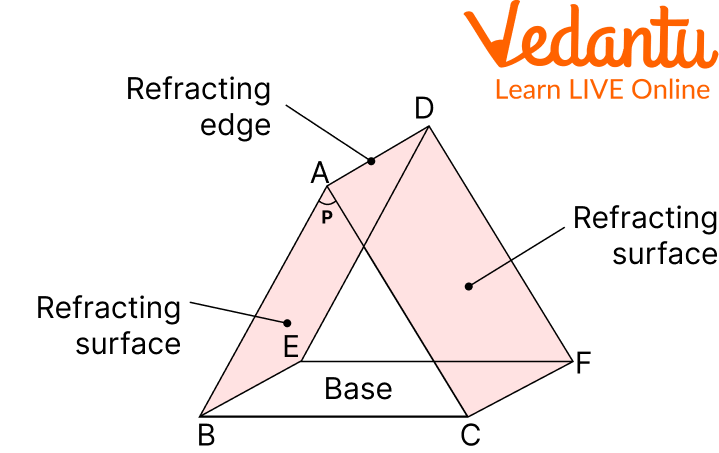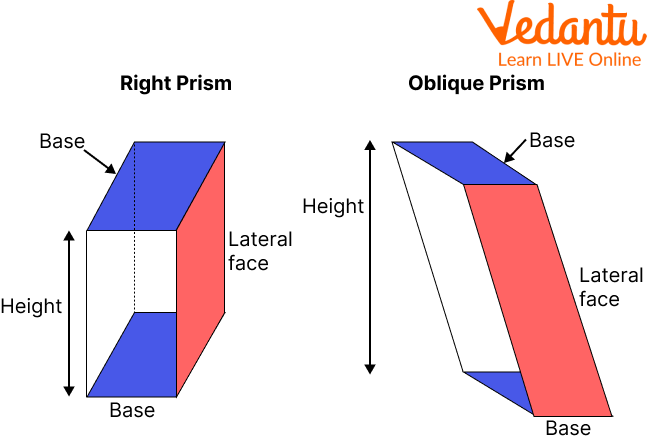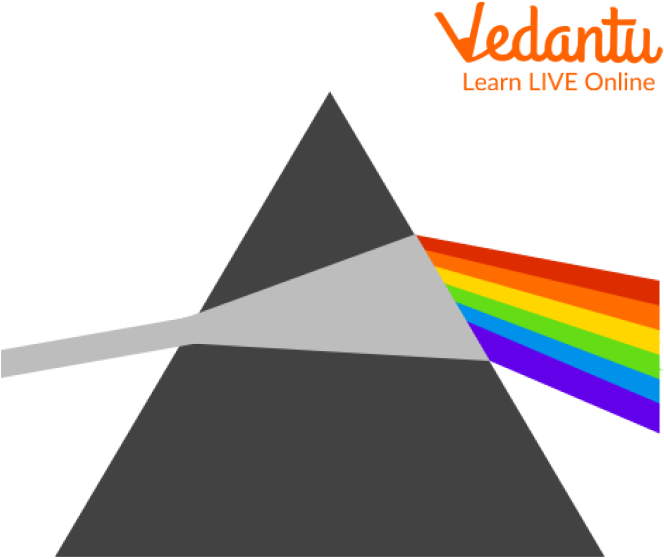




How Do Prisms Work? Properties, Examples & Applications Explained
A prism is an object which is solid and with various characteristics like it has identical ends and flat faces and it has the same cross-section the entire way through. The shape created by cutting an object directly across is called a cross-section. This object's cross-section is a triangle. It is a triangular prism because it has the same cross-section along its entire length. A prism separates light in its many colours. Let’s discuss prism more, let us know what a prism does and how to use it. So let’s dive in!
Different Shapes of Prism
A prism is a great tool for graphically illustrating that white light is made up of seven different colours. Each of a prism's parallel ends is referred to as a base.
A prism is an excellent and amazing tool for graphically illustrating how there are seven distinct colours in white light.
Parallelograms make up a prism's side faces (4-sided shapes with opposite sides parallel). A cube is a prism because of the continuous, square pattern that runs throughout the length. Due to the regular cross-section, each of the aforementioned examples is a Regular Prism (in other words, it is a shape with edge lengths that are equal in size and angles). It is an unusual pentagonal prism that lacks "regularity" in its cross-sectional shape.

Prism
Oblique Vs Right Prism
When the two ends are perfectly aligned, it is a right prism. If not, it is an Oblique Prism.
Surface Area of a Prism = 2 × Area of the base + Base Perimeter × Length
A prism basically refracts the light, light is refracted as soon as it enters a prism. Due to the distribution of colours throughout the spectrum, you may see them (spread out).
After all, each spectrum colour is refracted distinctly.

Right Prism Vs Oblique Prism
What is Refraction of Light?
Light refraction, as used in physics, is the optical phenomenon in which light is bent as it passes through another substance. When a light beam passes through the atmosphere and comes across the polished surface of a glass prism, for example, refraction takes place.

Prism Showing Refraction of Light
The angle of the deviation of light in this situation will be determined by the glass's refractive index. The deviation of light also depends on the incidence angle at which it strikes the prism's surface.

Prism Making Light Disperse
What Connection Exists Between the Color of Light and its Wavelength?
Each colour in the visible light spectrum has a unique wavelength and is made up of various colours. In fact, the human eye is capable of perceiving wavelengths between 390 and 700 nm. In that sequence, the following colours represent this spectrum of wavelengths:
Purple, Blue, Cyan, Green, Yellow, Orange, and Red
However, wavelengths beyond the visible light spectrum are invisible to the human eye. For instance, UV radiations, which are not visible, are emitted at wavelengths below 390 nm. This explains why infrared emissions at longer wavelengths are invisible to us.
Diagram Your Rainbows
Let us look at the process of how to use a prism in order to get a spectrum of light.
Materials
Prism
White paper
Colourful pencils
Sunlight
Students assemble their prism diagrams in pairs. They make their prism display colours by placing white paper on a table and using sunshine. The other student draws pictures of the colourful light emanating from the prism with coloured pencils. To see whether they can acquire the colours in a different order or the light in a different shape, students experiment with a variety of setups.
How do Prisms Work?
The underlying scientific idea is that the refractive index of the prism is a function of the wavelength of the light that passes through it. As a result, when a beam of white light strikes a prism, each of the wavelengths that make up the white beam's full range of colours will deviate at a certain angle. In other words, a vibrant rainbow will be formed when the white light is split. This optical phenomenon is comparable to the rainbows in the sky that are caused by water droplets diffracting the light.
How to Use a Prism?
It is quite simple to understand how to use a prism. Look at the steps given below.
Materials
A variety of pattern-different paper scraps
A range of shapes and sizes of prisms
Investigate how placing prisms on top of various patterned papers change the pattern's direction. Examine the ways through each prism and consider how the prisms' various sizes and shapes vary in how the designs look. Encourage children to describe why they think the prism affects how the pattern looks.
You can use a torch if the weather is not sunny to understand how prisms work. Make a slit across a white card using the dark card. Placing the card will allow a thin light beam from the Sun to pass through. When you can see the light split into its many colours, place the prism over the light source and rotate it.
Summary
Prism is a fun and educational concept to learn. It is a three-dimensional mathematical shape. A triangular block of glass or perspex called a prism divides light into various colours. It is a very important topic as well. We study prism as a concept in optics(a branch in physics). This article made the concept of prism quite understandable and easy. We discussed what a prism does, what is refraction light and many more important things related to prisms. We hope you enjoyed reading this article, in case of any doubts, feel free to ask in the comments.
FAQs on Prism: Meaning, Types & Uses
1. What is a prism in science and what is its main purpose?
In science, a prism is defined as a solid, transparent optical element with flat surfaces that refract (bend) light. While they come in various shapes, the most common is a triangular prism. Its primary purpose is to split white light into its constituent colours through a process called dispersion, revealing the light's spectrum.
2. What is dispersion of light by a prism?
Dispersion is the phenomenon of splitting white light into its seven component colours when it passes through a prism. This happens because the refractive index of the prism's material (like glass) is different for each colour's wavelength. As a result, each colour bends at a slightly different angle, creating a colourful band known as a spectrum. The order of colours is typically remembered by the acronym VIBGYOR (Violet, Indigo, Blue, Green, Yellow, Orange, Red).
3. What are some real-world examples or applications of a prism?
The principle of a prism is seen in many real-world scenarios. The most common natural example is a rainbow, where tiny water droplets in the air act as miniature prisms, dispersing sunlight. Technologically, prisms are essential components in:
- Binoculars and Periscopes: To invert and reorient images.
- Spectrometers: To analyse the composition of light from a source.
- Cameras (DSLRs): In the viewfinder to direct the image to the eyepiece.
4. Why does a prism split white light but a glass slab does not?
The key difference is the geometry of the surfaces. A prism has non-parallel surfaces, which causes different colours of light to bend at different angles and emerge in separate directions, resulting in dispersion. In contrast, a rectangular glass slab has parallel surfaces. While light does disperse slightly inside the slab, the colours are recombined as they exit the parallel face, so the emergent ray is white light that is only laterally displaced, not dispersed.
5. What would happen if monochromatic light, like a red laser beam, is passed through a prism?
If monochromatic light (light of a single colour or wavelength) like a red laser is passed through a prism, it will not split into other colours. This is because there are no other wavelengths to separate out. The light will still undergo refraction and deviate from its original path as it passes through the prism, but it will emerge as the same single red colour.
6. How can you show that white light is indeed composed of seven colours using two prisms?
This can be demonstrated with Isaac Newton's famous experiment. First, allow white light to pass through a prism to produce a spectrum (VIBGYOR). Then, place a second, identical prism in an inverted position next to the first one. When the dispersed colours from the first prism enter the inverted second prism, they recombine. The light that emerges from the second prism is a single beam of white light, proving that white light is a composite of the spectral colours.









